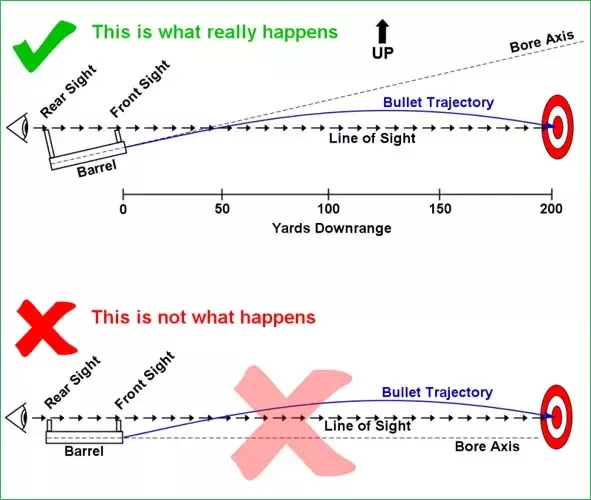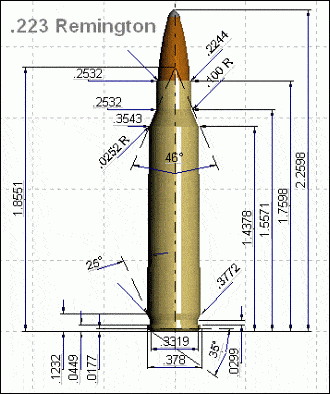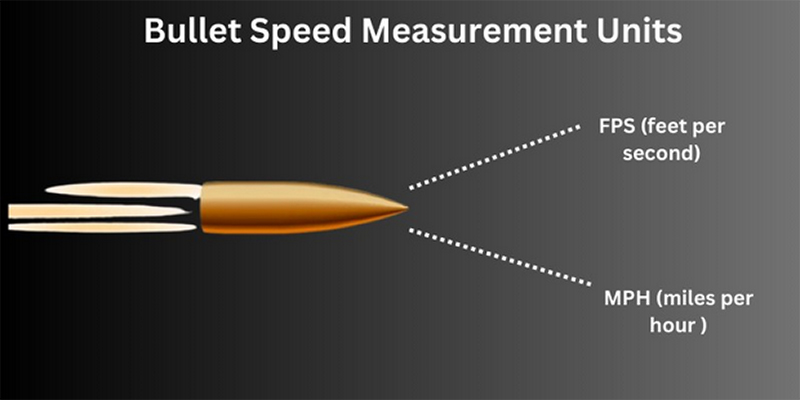How far will a bullet travel? The answer depends on many factors, including the bullet’s caliber, weight, shape, the firearm it’s fired from, and the conditions under which it’s shot. On average, a bullet can travel from one to five miles, but this range varies widely.
For example, a standard 9mm handgun round might reach up to 2 miles (3.2 km) if fired at an upward angle with no obstructions. However, its effective range—where it remains accurate and powerful—is usually only 50 to 100 yards.
In contrast, a high-powered rifle round like the .308 Winchester or .30-06 Springfield can travel much farther, with maximum ranges of 3 to 5 miles (4.8 to 8 km) under ideal conditions.
A military-grade .50 BMG round, used in sniper rifles, can exceed 7 miles in maximum travel, although it’s effective up to about 1.5 to 2 miles.
It’s important to note that the maximum distance a bullet can travel is based on a near-perfect firing angle—usually between 30 and 45 degrees. Real-world shooting often occurs at flatter angles, and environmental factors like wind, elevation, and terrain all affect the actual distance a bullet will go.
While bullets may lose accuracy and speed over distance, they can remain dangerous far beyond their intended target. That’s why safe shooting practices are essential, especially in open areas.
In summary, while a bullet may theoretically travel several miles, its practical range is much shorter. Always consider your surroundings and use proper backstops to ensure safety when firing any firearm.
What Affects How Far a Bullet Travels?
The distance a bullet travels is influenced by several key factors that work together to determine how far—and how accurately—it can go. One of the biggest factors is bullet caliber and weight.
Larger, heavier bullets may retain energy longer, but lighter bullets often travel faster. The shape of the bullet also matters; pointed, aerodynamic bullets (used in rifles) experience less air resistance and travel farther than round or flat-nosed bullets.
Another major factor is the type of firearm used. Rifles, with longer barrels, create higher muzzle velocities, allowing bullets to travel much farther than bullets fired from handguns, which have shorter barrels and slower speeds. For instance, a .308 rifle round can travel up to 5 miles under ideal conditions, while a 9mm handgun round may reach about 1–2 miles.
The angle at which the bullet is fired is also critical. A bullet fired at around 30 to 45 degrees can achieve maximum horizontal distance, while a straight or flat shot will travel less far due to gravity acting more quickly on its path.
Environmental conditions such as wind, temperature, humidity, and especially altitude can also affect bullet range. At higher elevations, air is thinner, so there’s less drag on the bullet, allowing it to travel farther.
Lastly, the bullet’s velocity—how fast it leaves the barrel—is essential. Higher velocity means more energy and a longer potential range. That’s why military or long-range precision rounds travel much farther than typical handgun bullets.
In summary, bullet travel distance is determined by a combination of caliber, firearm type, bullet shape, firing angle, and environmental conditions. Understanding these variables is key for both performance and safety in any shooting scenario.
Handgun vs. Rifle Bullet Range

When comparing handgun and rifle bullets, the differences in range are significant due to variations in barrel length, muzzle velocity, and bullet design.
Rifles are designed for long-distance shooting, while handguns are built for close-range accuracy and portability. As a result, rifle bullets typically travel much farther and remain effective over greater distances than handgun rounds.
A standard 9mm handgun bullet, for example, has an effective range of about 50 to 100 yards and can travel a maximum of 1 to 2 miles (1.6 to 3.2 km) if fired under ideal conditions at an upward angle. The .45 ACP is another common handgun round, with slightly less range—about 1 mile max—due to its slower speed and heavier weight.
In contrast, rifle bullets like the .223 Remington or 5.56 NATO (used in AR-15-style rifles) have effective ranges of 300–500 yards, and maximum distances of 2 to 3 miles. Heavier-caliber rifle rounds, such as the .308 Winchester or .30-06 Springfield, can travel even farther—up to 4 or 5 miles in ideal conditions.
A military-grade .50 BMG round can exceed 7 miles, though it is accurate and lethal up to 1.5 to 2 miles.
The extended range of rifles comes from their longer barrels, which give bullets more time to accelerate, and their higher muzzle velocity, which allows bullets to fight air resistance and gravity more effectively.
Rifle bullets are also more aerodynamic, with pointed tips designed to maintain speed and stability over long distances.
In summary, rifles dramatically outperform handguns when it comes to bullet travel distance. For shooters concerned with long-range accuracy, target shooting, or hunting, rifles are the superior choice.
Real-World vs. Theoretical Bullet Distance
When it comes to bullet range, there’s a major difference between theoretical maximum distance and real-world effective distance.
The theoretical distance refers to how far a bullet could travel under perfect conditions—no obstacles, no wind, and fired at the optimal angle (typically around 30 to 45 degrees).
In this ideal scenario, even a standard bullet from a handgun could travel over a mile, while high-powered rifle bullets like the .308 Winchester or .50 BMG might reach 4 to 7 miles.
But real-world conditions are never perfect. Gravity, wind, humidity, elevation, air resistance, and the angle of fire all influence how far a bullet will actually go. More importantly, the effective range—how far a bullet remains accurate and lethal—is much shorter.
For example, a 9mm handgun bullet may have a theoretical range of 2 miles, but in practical use, it is effective only up to 50–100 yards. Similarly, a .223 rifle round may theoretically travel over 3 miles but is most accurate and useful within 300–500 yards.
Real-world range also depends on the shooter’s skill, firearm optics, and bullet design. Wind drift and bullet drop become more significant the farther the bullet travels. That’s why long-range shooters and snipers account for ballistics charts, use high-powered scopes, and often shoot in controlled environments.
Understanding the difference between these two types of range is essential for both safety and practical shooting. While a bullet might travel miles in theory, responsible shooters must always consider what lies beyond the target—because even missed shots can be dangerous far beyond the visible range.
Effective Range vs. Maximum Range
When discussing how far a bullet can travel, it’s important to understand the difference between effective range and maximum range. These two terms refer to very different aspects of a bullet’s flight and are crucial for both accuracy and safety.
The maximum range of a bullet is the farthest distance it can physically travel if fired under ideal conditions—usually at an upward angle of 30 to 45 degrees with no obstructions.
For example, a .223 rifle round can potentially travel up to 3 miles, and a powerful .50 BMG round may reach 7 miles or more. However, this range assumes perfect ballistic flight and does not account for accuracy or effectiveness at that distance.
In contrast, the effective range is the distance at which a bullet can reliably hit a target with enough force to be accurate and lethal.
This is much shorter than the maximum range. A 9mm handgun, for instance, has a maximum range of about 1.5 to 2 miles, but its effective range is closer to 50 to 100 yards. A .308 rifle round may be deadly up to 5 miles, but it’s most effective within 800 to 1,000 yards, where it can be aimed precisely and deliver predictable results.
Knowing the difference helps shooters choose the right firearm for their purpose—whether it’s self-defense, hunting, or target shooting—and helps ensure bullets don’t go beyond intended targets.
More importantly, understanding effective vs. maximum range prevents dangerous assumptions, like believing a missed shot will simply drop nearby. In reality, it may continue flying for miles.
In short, the effective range is about controlled impact, while maximum range is about total flight distance. Every responsible shooter should know both.
How Elevation and Terrain Impact Bullet Flight
Elevation and terrain can significantly affect how a bullet travels after it is fired, influencing both its distance and accuracy. At higher elevations—such as in mountainous regions—the air is thinner, meaning there is less atmospheric resistance.
This reduced drag allows bullets to maintain their velocity longer, resulting in flatter trajectories and greater distances. That’s why long-range shooters often train at high altitudes—bullets travel faster and farther, and wind behavior is often more predictable in certain mountain environments.
Terrain also plays a critical role, particularly in how the angle of the shot interacts with gravity. Shooting uphill can reduce a bullet’s range and impact, as gravity acts against its flight path sooner.
On the other hand, shooting downhill can extend a bullet’s trajectory, allowing it to stay airborne longer and hit targets at a greater distance. However, aiming directly uphill or downhill also changes how gravity affects bullet drop, making it harder to predict exact points of impact without adjusting your aim.
Additionally, uneven or obstructed terrain—such as hills, forests, buildings, or canyons—can interfere with a bullet’s travel.
Not only can these obstacles block or deflect the bullet, but they can also create airflow patterns (like updrafts or crosswinds) that influence accuracy. In valleys and gorges, for example, wind may swirl unpredictably, throwing off long-distance shots.
For both casual shooters and professionals, understanding how elevation and terrain impact bullet flight is essential. It helps in making accurate long-range shots, choosing appropriate shooting locations, and, most importantly, maintaining safe shooting practices in varied environments.
Bullet Ranges by Caliber

Bullet range can vary dramatically depending on caliber, with each type offering different levels of power, accuracy, and travel distance. Caliber refers to the diameter of the bullet, and it plays a major role in how far and how effectively a bullet can travel. Let’s look at the average maximum and effective ranges for some of the most common calibers.
A .22 LR (Long Rifle) is a small, lightweight rimfire round used in rifles and pistols. Its maximum range can exceed 1.5 miles (2.4 km), but its effective range is only around 150 yards due to limited energy and wind resistance.
A 9mm bullet, commonly used in handguns, has a maximum range of 1.5 to 2 miles, but its effective range for self-defense or target shooting is typically 50 to 100 yards.
The .45 ACP is a heavier, slower bullet with a maximum range of about 1 mile and an effective range of 50 to 75 yards, making it ideal for close-range accuracy and stopping power.
Moving to rifles, the .223 Remington (or 5.56 NATO) used in AR-15-style rifles can travel 2 to 3 miles, with an effective range of 300 to 500 yards for accurate shooting.
The .308 Winchester, a powerful rifle round, can exceed 4 to 5 miles in maximum range and has an effective range of up to 1,000 yards in trained hands.
Finally, the massive .50 BMG round used in long-range sniper rifles has a maximum range of over 7 miles, though its effective range for precision is about 1.5 to 2 miles.
Understanding bullet ranges by caliber is crucial for choosing the right firearm, shooting safely, and knowing what to expect in the field.
Conclusion
Understanding how far a bullet can travel is essential for anyone who owns, handles, or is simply curious about firearms.
While bullets may have impressive theoretical maximum ranges—sometimes reaching several miles—their real-world effective ranges are significantly shorter. These practical distances are what matter most for safe, accurate, and responsible shooting.
Key factors like caliber, bullet weight, barrel length, firing angle, and environmental conditions all influence a bullet’s flight. Rifles, with their higher velocity and more aerodynamic bullets, generally offer longer ranges than handguns.
For example, a 9mm bullet might travel up to 2 miles under ideal conditions, but is only reliably effective within 100 yards. In contrast, a .308 rifle round could fly 5 miles or more, but is most accurate within 1,000 yards.
It’s also important to consider the effects of terrain and elevation. High altitudes can increase range due to thinner air, while shooting uphill or downhill affects bullet drop and trajectory. These factors highlight why real-world conditions often limit bullet travel compared to what’s possible on paper.
Most critically, understanding bullet range helps ensure safe shooting practices. Knowing how far a bullet might travel—even if it misses the target—can prevent accidents and save lives. Always use proper backstops, shoot in designated areas, and consider what lies beyond your target.
In summary, the question “how far will a bullet travel?” doesn’t have a single answer—it depends on the firearm, the bullet, and the environment. But by learning the science behind bullet travel, shooters can make informed decisions, improve their skills, and most importantly, stay safe.

